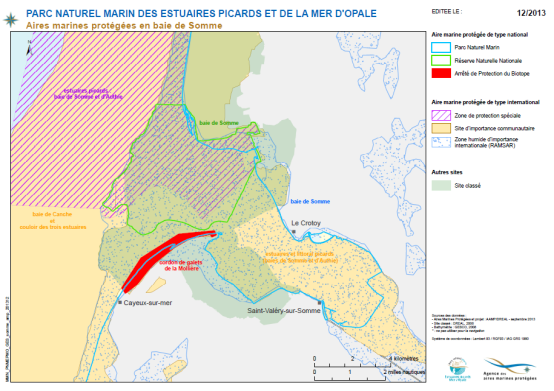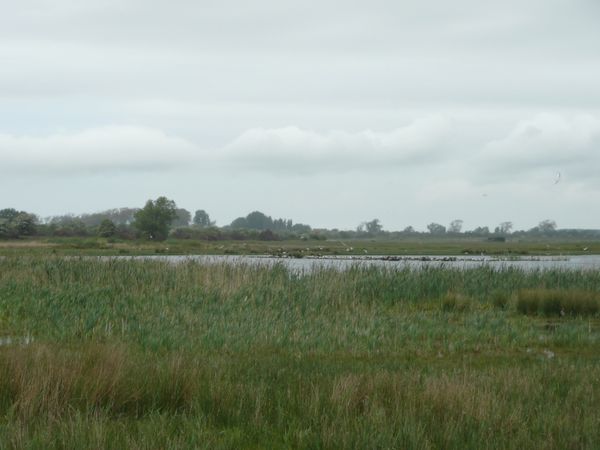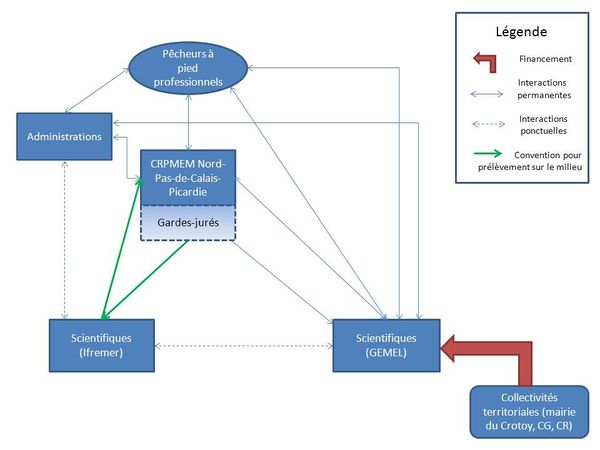Professional fishermen by foot at the Somme Bay and their governance (France)
Professional fishermen by foot at the Somme Bay and their governance (France)
Contents
Introduction and history
The Bay of Somme (Figure 1) forms the first French shell deposit reservoir and contains large areas of marine plants (samphire (glasswort), sea aster and sea sodas). Picking marine plants is an important part of the income of professional fishermen-by-foot at the Somme Bay. This is a traditional activity inseparable from all the professional fishing-by-foot activity in the Bay.

- Figure 1 : Map of the management tools and protection of the Bay of Somme. (Source : Parc naturel marin des Estuaires picards er de la mer d’Opale, décembre 2013)
The professional fishing-by-foot activity is a gathering activity, often considered as one of the traditional crafts of the coast, which must take place between sunrise and sunset. Professional fishing-by-foot is diverse, depending on which species caught, which fishing sites, equipment and techniques used but it is also very fragile due to the dependence on natural stocks and good physical-chemical appearance of the environment.

- Figure 2. The Somme Bay. Source : Thomas, April 2014.
In the 1980s, the distribution of the shells in the bay had to deal with serious deaths and the industrial sector went through some years of crisis. The Somme Bay had also to cope with a continuing process of siltation since the early twentieth century. The inshore fishing activity then disappeared gradually since the 1980s. Many fishermen changed to fishing by foot, although for the collection of Salicornia (glasswort), little historical indices are available. Salicornia (glasswort) has long been used as a seasoning salt and so significant amounts were going to Paris in the early twentieth century. Nobody knows why or when glasswort had "fallen into oblivion." It was the Dutch who, in the late 1970s, had boosted the production of glasswort and aster in the Somme Bay (Personal communication of a local association, 2014). Faced with the growing enthusiasm for the profession of fisherman-by-foot, access to deposits of shells was framed in the 1980s through the issuance of a fishing authorization by the competent authorities[1]. A clear basis of the recognition of the profession was set at national level in 2001 by the fishing authorization existing in the Somme Bay. In 2003, fishermen-by-foot have requested CRPMEM Nord-Pas-de-Calais and Picardy for the establishment of fishing licenses and the employment of permanent guard-jurors (Personal communication CRPMEM, 2014). In 2004, CRPMEM the Nord-Pas-de-Calais and Picardy had set up a license for fishing-by-foot on scallops and they employed two guard-jurors[2].
Governance organisation
Fishing by foot is a historical activity imbedded in the Somme Bay. Just like most of the French coastal fisheries, the fishing by foot profession is framed by a system of co-management of professionals and the government working together to regulate the resource and occupation[3]. In addition to this co-management, the governance, which was developed for this activity in the Bay of Somme, was able to adapt to the specificities of the territory and the needs of the professionals. Professional fishermen-by-foot therefore enjoy a degree of autonomy because they hold a controlling stake in the management of the fishery. Although the decision making is participatory and gives all stakeholders the opportunity to express their positions, the stakeholders of the co-management do not all have the same role and the same levels of intervention:
- The administration is essential in the management of the fishing-by-foot business since it comes with the regulatory decision-making;
- The CRPMEM Nord-Pas-de-Calais Picardie has a represented structure for the profession of shore fishery in the Somme Bay. This structure represents the fishermen from the State, its local services and local authorities in order to defend their interests and sustainability of the fishery at local, regional and national levels;
- Scientists: collaboration and exchange of information of Ifremer (French research institute for the exploitation of the sea) and the Research Group of Environments Estuarine and Coastal Areas. In this co-management decision-making system, scientists have an advisory role.
Moreover, the means used by local authorities involve the sustainability of fishing by foot on the territory and the balance of governmental activities.
Figure 3 provides a description of existing inter-linkages among the various stakeholders in the governance of professional fishing-by-foot in the Bay.

- Figure 3 : Interactions of governmental stakeholders of the profession of fishing by foot in the Somme Bay. (Source : Personal communication, 2014)
Perspectives of the Fishery
The profession of fishermen-by-foot may still experience changes at regulatory, social and economic level. The fishermen-by-foot activity in the Somme Bay must evolve to adapt to new conditions and must diversify ways of valuating and communicating of the possibilities of the Bay so they won’t be dependent and they will assure the sustainability of their work. Moreover, the diversification potential of this activity in the Bay is displayed.
The main obstacles today of the governance of this fishery are mainly located at the valuing of the products and the diversification of the professionals. It is often experienced by the profession who has to be successful, while it should not be. More generally, it seems that the economic potential of the sector is under-exploited, both the professionals as the public part. The two main problems to be solved by all the governmental stakeholders are filtering shells on land and the problem of the market for the shells, the lavagnons and the marine plants. The shellfish growing center at Crotoy consists of fantastic and unique tools of its kind that the industry must take ownership of it. The potential it represents for purification also favor local organization of shell-fishermen by foot in the Bay.
In the Somme Bay, professional fishing-by-foot has a significant economic importance and a social influence is clearly present. Despite an enclosed geography, the governance of the fishermen by foot at the Bay consists of the ensemble of all the local stakeholders involved in the management of the activity but the balance remains fragile due to the predominance of certain key players in this governance-system and especially with the lack of an organization of the professionals who fish on the shells in the area. The whole issue is that the governance of the fishermen-by-foot from the Somme Bay is in the same organization as the professionals. A federative association or the creation of a cooperative in the Somme Bay could be one way to allow the continuation of the activity and the success and development of territorial and maritime projects. More political and economic weight would favor the maintenance of the activity, taking into account its stakes in local projects and perhaps offer more financial investments.
Bibliography
- ↑ LOARER M., 2013. La pêche à pied professionnelle, Mémento, Ecole d'administration des Affaires Maritimes, Enseignement militaire supérieur du 1er degré, Diplôme technique, 63 p.
- ↑ ACHOIRES S., La pêche professionnelle à pied : bilan et perspectives, CNPMEM, Avril 2004, 25 p.
- ↑ PICAULT D., LESUEUR M., 2014. Pêche côtière et gouvernance en France. La gouvernance de la pêche dans les eaux territoriales française. Axe 1 du projet GIFS. Les publications du pôle halieutique AGROCAMPUS OUEST n° 20, p.